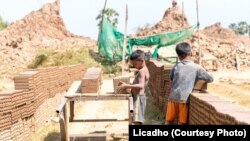Cambodia has launched a campaign to end child labor in the brick industry by 2020, a move industry observers cautiously welcome while expressing doubts the goal will be achieved, and calling for more structural changes.
The industry drew international attention last year when a report, Blood Bricks: Untold Stories of Modern Slavery and Climate Change from Cambodia, asserted poverty, often caused by climate change, forced tens of thousands of Cambodians into debt bondage at brick kilns, and again in March when a 9-year-old girl lost her arm working in one of the factories.
The government fined the factory and issued a directive barring children from brick kiln production line compounds. Children often live with their families in accommodation provided for by the brick factory, which often is in the direct vicinity of the kilns.
The government said Aug. 31 that the director of the Labor Ministry's Child Labor Department, Veng Heang, had started the campaign August 26 in cooperation with local authorities.
“According to the department director, any brick factory found having child labor will be severely penalised without any excuse,” the state news agency Agence Kampuchea Presse reported.
One of the authors of the Blood Bricks report, Laurie Parsons, welcomed the initiative, saying child labor was still prevalent in the industry and estimating that the number of children working in brick factories ranged “in the thousands.”
Parsons said the government had denied the issue for years and as late as last year, despite multiple reports by nongovernmental organizations, but now had started to acknowledge the issue because of increased international media attention.
“Although the issue has been known, it hasn't been internationally known,” Parsons said.
He welcomed the initiative but called just focusing on child labor a “symptom-led approach” not likely to address the root causes of the problem. He said that poverty pushes people into debt-bondage at the brick kilns, poor working conditions, and brick kiln contracts barring workers from employment elsewhere.
“It's a focus which won't necessarily produce any long-term tangible change, [which] is very much a kind of symptom-led focus with what we see as being an undue focus on the issue of child labor, which is obviously a very evocative topic,” he said. “It's something that gets a lot of attention. But to us, the child labor is essentially part of the wider structural problem.”
“The reason that these conditions exist is essentially because people are desperate enough to keep bonding themselves into work in the brick industry,” he said.
The ministry remained evasive, however, about what concrete measures would be taken to combat child labor. Asked what the government would do once the inspection was done, ministry spokesman Heng Sour said: “I would like to inform you that our labor inspectors are still on their mission to inspect all brick factories across the country, which will conclude in late October. We will publish the report in this November.”
Sour did not answer questions about further details of the campaign and what steps the government would take.
Parsons said the success of the campaign depends on the concrete measures that have been taken, and whether the brick kiln owners' claims they don't directly employ children but only buy bricks will be tolerated. "It has to have a really sweeping overhaul of the entire industry,” he said.
Sou Chhlonh, vice director of the Building and Wood Workers Trade Union Federation of Cambodia, agreed.
Chhlonh said it would be easy for brick factories to avoid being fined if inspections were conducted on a one-off basis. Factories could easily have no children on site for one week, for example, and revert to children working there after the inspection was done, he said.
To make matters more complicated, he said, children were largely not employed by the factory owners directly, but rather helped – voluntarily or involuntarily – their parents instead of going to school to lighten their parents' debts. Sometimes, brick kiln owners tell parents to get their children to work to pay their debts, he said, but this was not always the case.
Sour told VOA the government would show “zero tolerance” on the issue.
“The main mission is zero tolerance to child labor, and debt bondage in the brick factory,” he said. “So, the labor inspector is doing such inspection, education, and raising awareness among the workers who work in the brick factory.”
Chhlonh said training those inspectors is crucial for the success of the campaign, and raised doubts that child labor could be erased by the government's deadline.
“It’s so fast,” he said. “We should train more inspectors [first].”
Pointing to the comparatively small size of the industry – Parsons estimated that about 10,000 people were involved in about 450 kilns in the country – the researcher said significant improvements could be made quickly.
However, “in practice, of course, it's not going to happen by 2020," he said, "because resources won't be put in place, and the kind of structural attitude won’t be there.”







